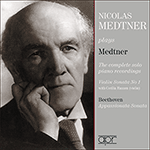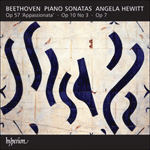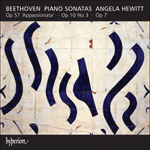
Welcome to Hyperion Records, a British classical label devoted to presenting high-quality recordings of music of all styles and from all periods from the twelfth century to the twenty-first.
Hyperion offers both CDs, and downloads in a number of formats. The site is also available in several languages.
Please use the dropdown buttons to set your preferred options, or use the checkbox to accept the defaults.


The ‘Appassionata’ (the title was added by the publisher Cranz when a version for piano duet was issued in 1838) was Beethoven’s own favourite piano sonata until he wrote his Op 106. In 1803 he had been given an Erard piano which had an extended range of five-and-a-half octaves, and he uses this at the very beginning of the piece, going down to the lowest note available—the bottom F. Nowadays it can seem all too commonplace. Given the energy and force that Beethoven was by then putting into his works, it is not surprising that the instrument was worn out by 1810. Czerny calls this sonata ‘the most perfect execution of a mighty and colossal plan’, and advises the player to observe strict time, except where marked. Tovey, saying that no piano work of Beethoven has suffered more from that vile thing known as pianistic ‘tradition’, also urges us to trust Beethoven and play what he writes. There are numerous places where we are used to hearing dynamics that are simply not there, or tempo changes that are not indicated at all. The extremes of the piano are used to great effect—for example at the recapitulation when the left hand quietly drums out the low repeated C (which must be done without changing fingers to get the best effect). The ‘fate’ motive made famous in his Fifth Symphony is everywhere, contrasting with the second subject which has that wonderful Beethovenian warmth and expansiveness.
Instead of a proper slow movement, Beethoven doesn’t delay the action more than necessary, giving us a set of variations on a drastically simple theme (in fact it is no ‘theme’ at all, but rather a series of chords). The tempo of Andante con moto is another marking that is frequently ignored. Abruptly interrupting this extemporization comes a crashing diminished-seventh chord, announcing one of his greatest examples of keyboard writing, the final Allegro ma non troppo. Ferdinand Ries, a student of Beethoven and one of his biographers, relates how this movement came about. Ries went for a lesson and found Beethoven working something out at the piano, but seeing that it was a nice day they decided to go out for a walk instead. On the mountain slopes Ries suddenly heard a shawm playing a beautiful melody; he called attention to it, but Beethoven couldn’t hear anything. For many hours he was preoccupied with his own thoughts, humming out phrases and singing aloud. When they returned home Beethoven immediately sat down at the piano and played what later became the last movement of the ‘Appassionata’. The most remarkable thing about this movement is how much of the power is held back until the very end when all is unleashed. Czerny imagines ‘the waves of the sea on a stormy night, whilst cries of distress are heard from afar’. Perhaps it is not necessary to be quite so graphic, but the two-note sighing figures do certainly give that impression. Nobody had written anything nearly as powerful for solo piano before that, and it remains to this day a landmark in musical history.
from notes by Angela Hewitt © 2006
L’«Appassionata» (l’éditeur Cranz ajouta ce titre en 1838, lors de la publication d’une version pour duo pianistique) fut la sonate préférée de Beethoven, du moins jusqu’à son op. 106. En 1803, il avait reçu un piano Erard doté d’une étendue prolongée (cinq octaves et demie), dont il se servit en tout début d’œuvre, en atteignant la plus basse note disponible: le fa grave. De nos jours, cela peut sembler par trop banal. Vu l’énergie et la force que Beethoven mettait alors dans ses œuvres, on comprend que son piano ait été complètement usé en 1810. Czerny, qui voit dans cette sonate «la plus parfaite exécution d’un plan puissant et colossal», conseille à l’interprète de bien observer la mesure, sauf aux endroits marqués. Tovey—aux yeux de qui aucune œuvre de piano beethovénienne n’avait autant souffert de cette chose exécrable qu’est la «tradition» pianistique—nous exhorte lui aussi à faire confiance à Beethoven et à jouer ce qui est écrit. Il y a de nombreux endroits où l’on a l’habitude d’entendre des dynamiques qui n’y sont tout bonnement pas, ou des changements de tempo qui ne sont absolument pas mentionnés. Les extrêmes du piano sont utilisés avec force effet—ainsi à la réexposition, quand la main gauche expulse tranquillement l’ut grave répété (ce qu’il faut faire sans changer de doigts si l’on veut obtenir le meilleur effet). Le motif du «destin», fameux depuis la Symphonie no 5, est omniprésent et contraste avec le second sujet, tout de merveilleuse chaleur et d’expansivité beethovéniennes.
Au lieu de nous proposer un mouvement lent en tant que tel, Beethoven ne repousse pas l’action plus que nécessaire et nous offre une série de variations sur un thème remarquablement simple (en réalité, ce n’est en rien un «thème», plutôt une série d’accords). Le tempo de l’Andante con moto est, lui aussi, souvent ignoré. Un retentissant accord de septième diminuée vient brusquement interrompre cette improvisation, annonçant l’un des plus grandioses exemples de l’écriture de clavier beethovénienne, l’Allegro ma non troppo final. Ferdinand Ries, élève et biographe de Beethoven, relate la genèse de ce mouvement. Venu prendre une leçon chez Beethoven, il le trouva en train de travailler quelque chose au piano. Voyant que la journée était belle, les deux hommes décidèrent d’aller se promener. Dans la montagne, Ries entendit soudain une splendide mélodie au chalumeau; il la signala à Beethoven, mais ce dernier ne put rien entendre: pendant des heures, il demeura absorbé dans ses propres pensées, marmonnant des phrases et chantant tout haut. À leur retour, il se précipita au piano et joua ce qui devait devenir le dernier mouvement de l’«Appassionata». Le plus remarquable dans ce mouvement, c’est la manière dont une grande partie de la puissance est retenue jusqu’à la toute fin, où elle est relâchée. Czerny y voit «les vagues de la mer par une nuit de tempête avec, au loin, des cris de détresse». Nul besoin, peut-être, de se montrer aussi imagé, même si les figures soupirantes de deux notes ne sont pas sans donner cette impression. Personne n’avait encore rien écrit d’aussi puissant pour piano solo, et cette œuvre reste l’un des phares de l’histoire musicale.
extrait des notes rédigées par Angela Hewitt © 2006
Français: Hyperion Records Ltd
Die „Appassionata“ (den Titel fügte der Verleger Cranz beim Erscheinen einer vierhändigen Version 1838 hinzu) war bis zur Entstehung seines op. 106 Beethovens eigene Lieblingsklaviersonate. 1803 hatte er einen Erard-Flügel mit einem erweiterten Umfang von fünfeinhalb Oktaven geschenkt bekommen—einen Umstand, auf den er gleich zu Beginn des Stücks zurückgreift, indem er den tiefsten verfügbaren Ton—das tiefe F—einsetzt. Heutzutage kann dies allzu normal scheinen. Angesichts der Energie und Kraft, die Beethoven inzwischen in seine Werke investierte, ist es nicht verwunderlich, daß das Instrument bis 1810 abgespielt war. Für Czerny handelte es sich bei dieser Sonate um die vollkommenste Ausführung eines mächtigen und kolossalen Plans, und er rät dem Interpreten, außer wenn anders angegeben, streng im Tempo zu bleiben. Tovey, der die Meinung vertritt, daß kein anderes Klavierwerk Beethovens mehr unter jener abscheulichen Unsitte, die sich pianistische „Tradition“ nennt, gelitten habe, drängt darauf, Beethoven zu vertrauen und das zu spielen, was er geschrieben hat. An zahlreichen Stellen ist man gewohnt, eine Dynamik zu hören, die schlichtweg nicht da ist, oder Temposchwankungen, die nicht vorgegeben sind. Die extremen Bereiche des Klaviers werden besonders wirkungsvoll eingesetzt—zum Beispiel in der Reprise, wenn die linke Hand leise das wiederholte tiefe C trommelt (wobei man, um den besten Effekt zu erzielen, den Finger nicht wechseln sollte). Das durch die Fünfte Symphonie berühmt gewordene „Schicksals“-Motiv ist allgegenwärtig und steht im Gegensatz zu dem zweiten Thema, dem jene wundervolle, für Beethoven so typische Wärme und Großzügigkeit innewohnen.
Anstatt einen richtigen langsamen Satz zu komponieren, verzögert Beethoven das Geschehen nicht unnötig und schreibt eine Gruppe von Variationen über ein ausgesprochen einfaches Thema (das eigentlich gar kein „Thema“ ist, sondern eine Folge von Akkorden). Die Tempoangabe Andante con moto gehört ebenfalls zu denjenigen Anweisungen, die oft nicht beachtet werden. Diese Improvisation wird durch einen jäh herabstürzenden verminderten Septakkord unterbrochen, welcher eines von Beethovens herausragendsten Beispielen der Klaviermusik überhaupt ankündigt, nämlich das abschließende Allegro ma non troppo. Ferdinand Ries, ein Schüler Beethovens und einer seiner Biographen, hat überliefert, wie dieser Satz entstand. Ries erschien zum Unterricht, und als er ankam, arbeitete Beethoven irgend etwas am Klavier aus; da das Wetter aber schön war, beschlossen die beiden statt dessen spazierenzugehen. An den Berghängen hörte Ries plötzlich eine Schalmei eine wunderschöne Melodie spielen; er lenkte Beethovens Aufmerksamkeit darauf, doch dieser konnte nichts hören. Stundenlang war er mit seinen eigenen Gedanken beschäftigt, summte Phrasen vor sich hin und sang laut. Als sie nach Hause zurückkehrten, setzte sich Beethoven sofort ans Klavier und spielte das, was später zum letzten Satz der „Appassionata“ werden sollte. Das erstaunlichste an diesem Satz ist, wie viel von seiner Kraft der Komponist zurückhält, um sie erst ganz am Schluß voll zu entfesseln. Czerny erinnert der Satz an die Wellen des Meeres in einer stürmischen Nacht, während aus der Ferne Notrufe erklingen. Auch wenn diese Bilder etwas blumig wirken, erwecken die zweitönigen Seufzerfiguren doch in der Tat diesen Eindruck. Niemand hatte jemals zuvor etwas annähernd Kraftvolles für Soloklavier geschrieben, und diese Musik bleibt bis heute ein Meilenstein in der Musikgeschichte.
aus dem Begleittext von Angela Hewitt © 2006
Deutsch: Bettina Reinke-Welsh
 Medtner: The complete solo piano recordings Medtner: The complete solo piano recordingsAPR’s landmark issue on three CDs of Nicolas Medtner’s complete solo recordings, which included fifteen 78-rpm sides of previously thought lost Columbia recordings from 1931 and an unpublished HMV recording of his Violin Sonata No 1, are here reis ...» More |
 Beethoven: Beethoven Unbound Beethoven: Beethoven UnboundA comprehensive new cycle of the Beethoven sonatas recorded live at London's Wigmore Hall during the pianist's epic fourth rendition of these masterpieces .» More |
 Beethoven: Piano Sonatas Opp 10/3, 7 & 57 Beethoven: Piano Sonatas Opp 10/3, 7 & 57‘Angela Hewitt's first instalment in a projected Beethoven sonata cycle offers intelligent, stylish and often illuminating interpretations … fusi ... ‘Every bit as intellectually lucid, technically secure and focussed, as her Bach … this exhilarating clarity of thought is matched by her clean i ...» More |
 Edwin Fischer - The First Beethoven Sonata Recordings Edwin Fischer - The First Beethoven Sonata Recordings |
 Beethoven: Piano Sonatas Opp 10/3, 7 & 57 Beethoven: Piano Sonatas Opp 10/3, 7 & 57 |

